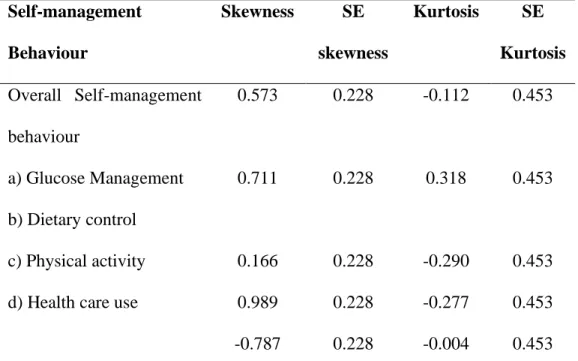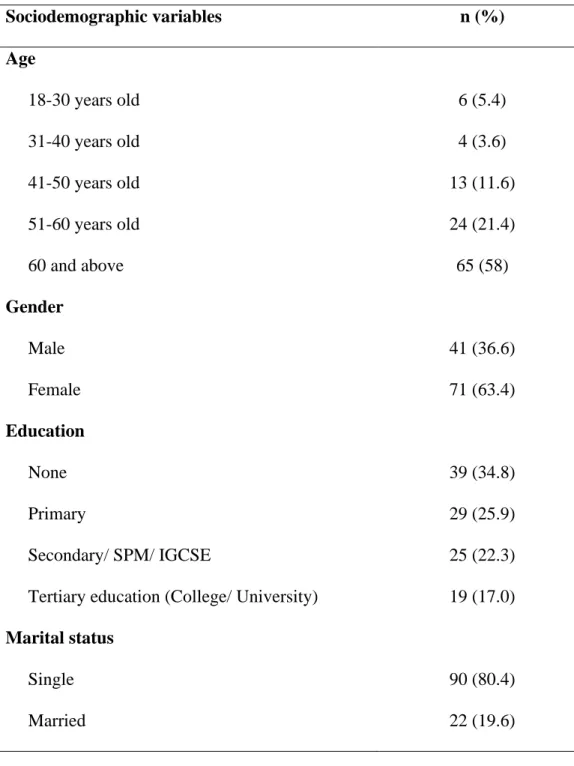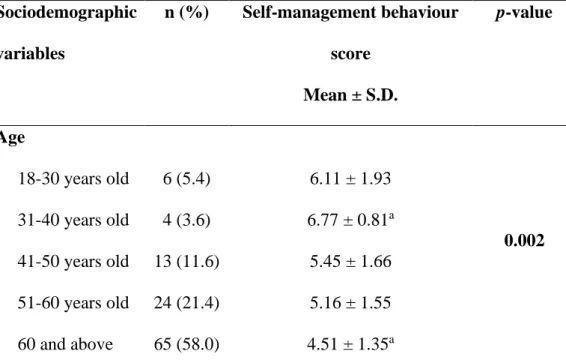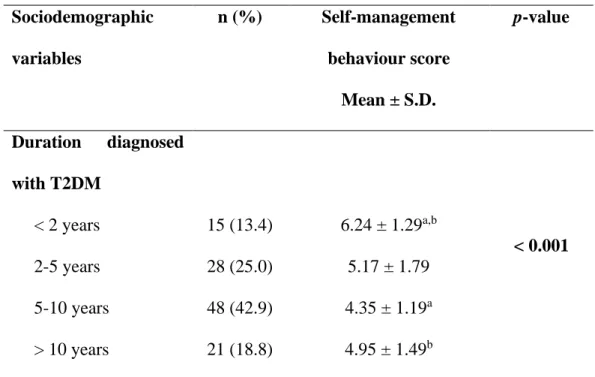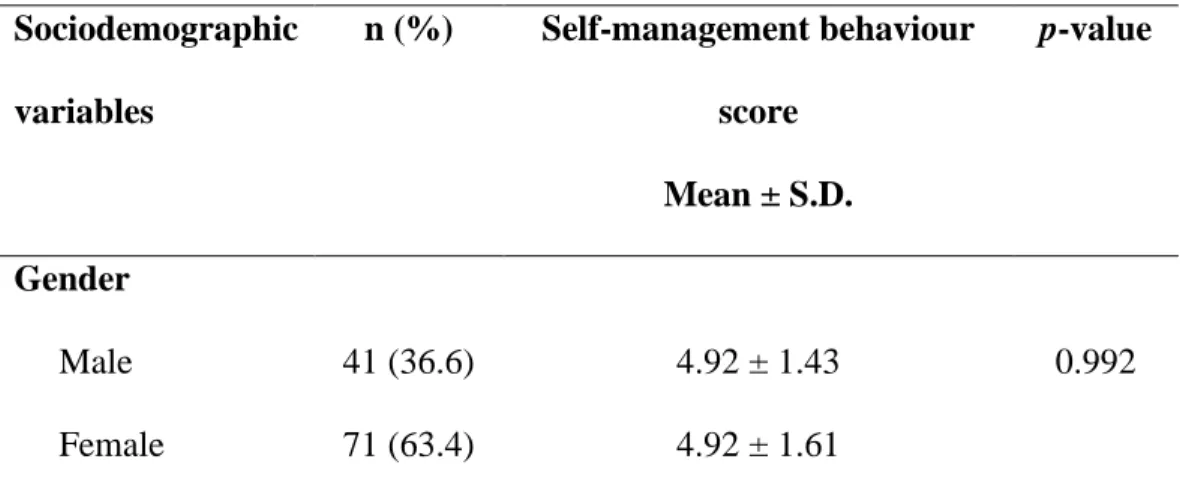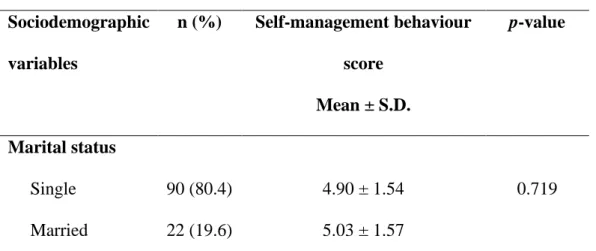This study therefore aims to determine the relationship between health literacy and self-management behavior of T2DM adults. Therefore, it was concluded that a significant relationship was found between health literacy and self-management behavior.
Research Background
Therefore, the health literacy level of T2DM adults is predicted to be lower. T2DM adults should have sufficient health literacy to understand the importance of self-management behaviors as well as practice self-management behaviors appropriately.
Problem Statement
Self-management behavior is important in preventing diabetes-related morbidities and mortality (Shrivastava et al., 2013). However, little is known about the relationship between health literacy and self-management behavior in T2DM.
Research Objective .1 General Objective
Specific Objectives
Alternative Hypothesis
Conceptual Definitions .1 Health Literacy
- Relationship
- Self-management
- Behaviour
- Type 2 Diabetes Mellitus (T2DM)
Operational Definitions .1 Health Literacy
- Relationship
- Self-Management Behaviour
- Adult
Fasting plasma glucose is ≥7.0 mmol/L, Oral glucose tolerance test with the result of 2-hour plasma glucose of ≥11.1 mmol/L or hemoglobin A1c (HbA1c) that is ≥45 mmol/mol (Clinical Practice Guidelines Management of Type 2) Diabetes Mellitus, 2020 ).
Significance of the Study
The research will also be able to demonstrate the importance of sufficient health literacy in adults with T2DM. Therefore, with sufficient health literacy among T2DM adults, it is expected that self-management behavior will be improved.
Search Strategy
Health Literacy among Type 2 Diabetes Mellitus Adults
This shows that T2DM adults in Malaysia have low health literacy levels in both studies. Therefore, the study is important to determine the relationship between health literacy and self-management behavior among T2DM adults.
Self-Management Behaviour in Type 2 Diabetes Mellitus Adults Several studies have been conducted to study on the self-management
- Glucose Management
- Dietary Control
- Physical Activity
- Health Care Use
Furthermore, self-monitoring of blood glucose was the least practiced self-management behavior by adults with T2DM (Mogre et al., 2017; Bezo et al., 2020). Dietary control by adults with T2DM was significantly associated with health literacy (Mehrtak, Hemmati, & Bakhshzade, 2018).
The Relationship between Health Literacy and Self-Management Behaviour in Type 2 Diabetes Mellitus Adults
24 In contrast, Reisi et al. 2016) which was also done in the population of Iran found no association between health literacy and self-management behavior among adults with T2DM. Self-efficacy shows a significant correlation with self-management behavior of adults with T2DM (Ji et al., 2020).
Research Design
Setting of the Study
Variables
Sample Size
In addition, the prevalence of T2DM among all those diagnosed with diabetes was 99.29%, based on the National Diabetes Registry Report. Therefore, the prevalence of T2DM was assumed to be 18.3% due to the high prevalence of diabetes individuals diagnosed with T2DM. In addition, based on NHMS 2019, the highest prevalence of individuals with overall diabetes is within the age range of 65-69 with 43.4%.
This is because the high prevalence of individuals with T2DM was among those of older age and they may have difficulty answering the questionnaire through the online method.
Sampling Design
31 In addition, the subjects who are diagnosed with T2DM in the nursing homes were also approached. The subjects were assisted by the nursing home nurses in answering the questionnaire, as the study was conducted during the Covid-19 pandemic period and visitation restrictions were imposed by the nursing homes. The researcher approached all T2DM adults to invite T2DM adults to participate in the study.
The subjects were contacted through phone calls or WhatsApp messages and the researcher explained all the study details to them and obtained their consent to participate in the study.
Inclusion and Exclusion Criteria
In addition, convenient sampling was done in the medical clinics where the researchers were employed. After the selected adult agreed to participate, a link to the questionnaire via Google Form was sent to them and they were asked to answer the questionnaire. 32 adults with T2DM who are able to read and understand English were also included in this study.
Adults not on diabetes medication or insulin therapy will also be excluded from the study.
Research Instrument
Sociodemographic Questionnaire
Health Literacy Questionnaire
Self-Management Behaviour Questionnaire
36 The highest self-esteem of the tested behavior was therefore a converted score of ten (Schmitt et al., 2013). A score of less than or equal to six was categorized as poor self-management behavior, while a score of more than six was categorized as good self-management behavior (Schmitt et al., 2014). The DSMQ questionnaire was also used in the study by Chahardah-Cherik et al. 2018) in Pakistan on similar populations and variables.
Not only that, it was also used in Malaysian adults with T2DM in the study by Ang et al.
Data Collection
The skewness and kurtosis of the distribution of self-management behavior is shown in Table 3.8.1. For the self-management subscale of dietary control, the absolute skewness value of 0.166, which is less than two, and the absolute kurtosis value of -0.290, which is less than seven, were obtained. Moving to the self-management subscale of physical activity, the absolute skewness value of 0.989 which is less than two and the absolute kurtosis value of.
Finally, for the self-management behavior subscale of health care use, the absolute skew value of -0.787, which is less than two, and the absolute kurtosis value of -0.004, which is less than seven, was obtained.
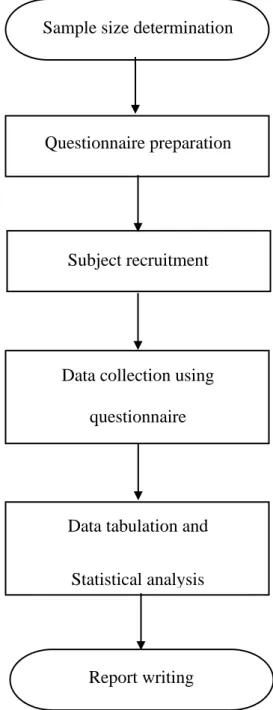
Statistical Analysis
Therefore, Independent T-Test and ANOVA were used for analysis, as all data for the self-management behavior and each self-management behavior subscale were normally distributed. The next goal of determining the level of self-management behavior among T2DM adults was also determined using mean and standard deviation. The purpose of determining the relationship between the level of health literacy and the overall level of self-management behavior was determined using One-way analysis of variance (ANOVA).
The next objective relating to the significant difference between the sociodemographic variables namely gender and marital status with self-management behavior was analyzed using Independent T-test while ANOVA was used to determine another objective of the relationship between sociodemographic variables (age, education level and duration diagnosed with T2DM) with self-management behavior as it contains more than two categories among the sociodemographic variables.
Results
As shown in the table, most of the subjects who participated in the study were 60 years and older (n= 65), which is equivalent to 58% of the total subjects. The least number of subjects falls in the age group of 31-40 (n=4) which is equivalent to 3.6 % of the total subjects. The results were obtained by summing up all the scores for the 18 questions to determine the health literacy of the subjects.
This reported health literacy of the study population is categorized as a level of "limited health literacy" (score 0-33).
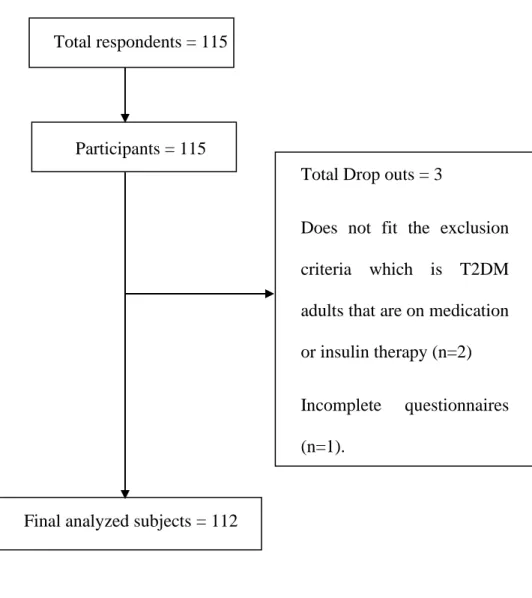
Self-Management Behaviour of T2DM Adults
Difference between Age and Self-Management Behaviour
Based on Table 4.4.2, the difference between sociodemographic data on education level and self-management behavior of T2DM adults was determined using the ANOVA test. As shown in the table, a significant difference between the education level of T2DM adults and self-management behavior shows at the p-value < 0.001. ANOVA was performed to determine the difference between sociodemographic data of duration diagnosed with T2DM and self-management behavior of T2DM adults as shown in Table 4.4.3.
Based on the ANOVA test, there is a significant difference between the three levels of health literacy and self-management behavior in the studied adults with T2DM.
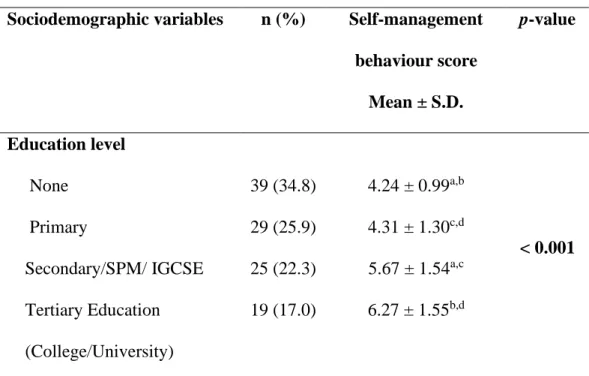
Relationship between Health Literacy and Glucose Management
The results obtained indicated that there is a significant difference between health skills and self-management behavior subscale of dietary control with a p-value < 0.001. 62 It can be concluded that T2DM adults with "limited health literacy" level (Average) have worse self-management behavior subscale of dietary control than T2DM adults with "adequate health literacy" level (Medium. Therefore, it can be concluded that T2DM adults with lower health literacy level have worse self-management behavior subscale of dietary control.
It has been shown that people with a level of "limited health literacy" performed (on average) less physical activity than those with "sufficient.
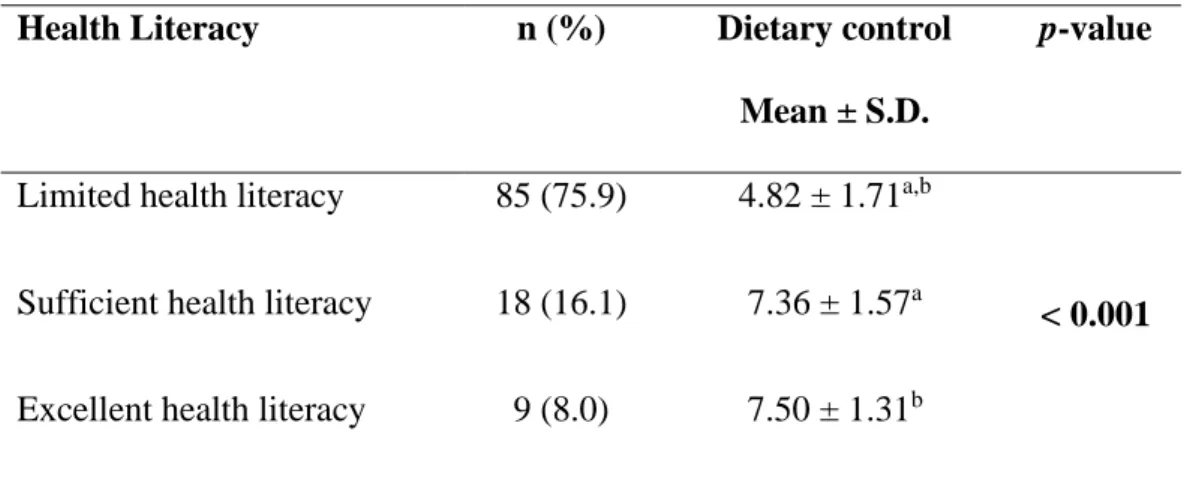
Relationship between Health Literacy and Health Care Use
Therefore, it can be concluded that T2DM adults with lower health literacy levels performed less physical activity compared to T2DM adults with higher health literacy levels.
Health Literacy Level among Type 2 Diabetes Mellitus Adults The findings of the studies show that the prevalence of T2DM adults has a
Continuing, a study by Finbråten et al. 2020) suggested that the health literacy of the individual should be enforced in education during primary and secondary school. This is because individuals with higher health literacy will have better general health (Finbråten et al., 2020). This is consistent with this study as the majority of the T2DM adults were single (80.4%) which may also contribute to the high prevalence of "limited health literacy" level.
Some of the subjects in this study live in nursing homes that may lack social communication and support networks and contribute to a lower level of health literacy.
Self-Management Behaviour among Type 2 Diabetes Mellitus Adults
Relationship between Health Literacy and Self-Management Behaviour Subscale of Glucose Management
The results obtained are that there was a significant difference between health skills with the self-management behavior subscale of glucose management. The results from this study indicate that T2DM adults with the level of “limited health literacy” have a poorer glucose management self-management behavior subscale than T2DM adults with the level of “adequate health literacy”. T2DM adults with “limited health literacy” level may have difficulty understanding the given dietary advice, leading to lower adherence (Friis et al., 2016).
The results obtained are that there was no significant relationship between health literacy and the subscale of self-management behavior in the use of health services.
Strengths of the Study
The findings of this study will provide a better picture of the relationship between health literacy and self-management behavior of adults with T2DM in Malaysia. Methods to increase the health literacy of adults with T2DM need to be reviewed and improved. Health promotion activities to increase the health literacy of T2DM adults should be done regularly and participation should be ensured by including various attractions.
In addition, adults with T2DM should also be screened to determine their level of health literacy in order to appropriately recommend appropriate self-management behaviors.
Implications for Future Research
Analysis of the relationship between referral and development of patients with type 2 diabetes mellitus. Factors influencing self-management behavior among patients with type 2 diabetes mellitus in the Solomon Islands. The relationship between health literacy and unintentional and intentional medication shortages in medically underserved patients with type 2 diabetes.
Association of health literacy and assessment of nutritional status with glycemic control in adults with type 2 diabetes mellitus. The effect of the COVID-19 pandemic on self-management in patients with type 2 diabetes mellitus. Title of the thesis THE RELATIONSHIP BETWEEN HEALTH LITERACY AND SELF-MANAGEMENT BEHAVIOR IN ADULTS WITH TYPE 2 DIABETES MELLITUS.

